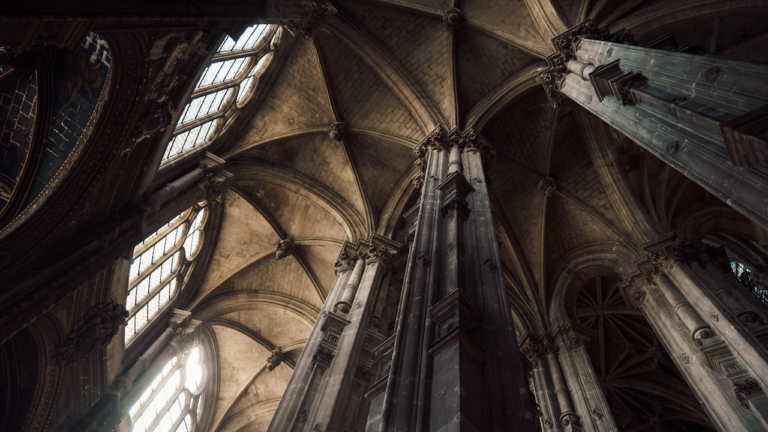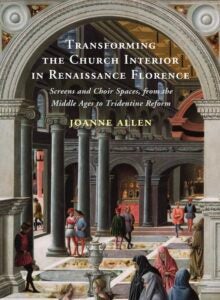
Scholar Q&A: Joanne Allen, Ph.D.
Joanne Allen, Ph.D., is a faculty member in the Department of Art at American University in Washington D.C. Her research investigates the function, accessibility and control of sacred spaces in medieval and early modern Italy. Prof. Allen teaches classes on Medieval and Renaissance art history, along with courses on Gothic Architecture and Renaissance Venice. She has written extensively about church architecture across Italy.
Her new book “Transforming the Church Interior in Renaissance Florence: Screens and Choir Spaces, from the Middle Ages to Tridentine Reform” (Cambridge University Press, 2022) explores church interiors, and their role in Florentine social and religious life during the Middle Ages and Renaissance.
IACS recently spoke to Prof. Allen about her new book.

IACS: What drew you to this subject?
Prof. Allen: As an undergraduate at the University of Warwick in the UK, I spent a semester living and studying in Venice, Italy. When I saw the choir screen in the Franciscan church of Santa Maria Gloriosa dei Frari for the first time, I was overawed. With its gilded marble reliefs of saints and prophets, the structure was not only artistically beautiful but it dramatically dominated the church interior in a way I hadn’t seen before. When I discovered that screens were common features in Italian churches before their destruction in the late 16th century, I had to find out more. I began to investigate the broader implications of this change during my doctoral work at Warwick, then I spent about 10 years researching and drafting my book on this topic. My book focuses on Florence and investigates the religious and aesthetic motivations behind these transformations of the church interior.
In addition, from a personal perspective, I have sung in Anglican church choirs since my teenage years and have had the opportunity to sing in many stunning Gothic cathedrals in my native England. Since my research intersects with music, acoustics and liturgy, it provides a terrific opportunity to combine my personal and professional interests.
IACS: What are screens, and what role did they play in church construction and religious life?
Prof. Allen: The medieval church was frequently divided, to a greater or lesser extent, into three main zones: the high altar area or presbytery reserved for priests; the choir, a restricted area of permanent seating for members of the officiating religious community (monks, friars, canons, etc.); and the remaining space in the nave, which was variably accessible to laymen and laywomen. Between these last two zones, an architectural screen, either integral or separated from the choir precinct, served to define this spatial layout. In essence, then, these screens (known as tramezzi in Italian) were used to create quiet, warm and sheltered choir areas for communities of monks, friars or priests to perform and attend religious rituals away from the perceived distracting influence of the laity. Almost granting the laity their own church in the lower nave, the screen approximated a separate interior façade, that was normally equipped with a rood (image of the crucified Christ in painted or sculpted form), pulpits for the reading of scripture, tombs, chapels and altars. Screens provided physical means to facilitate liturgical processions and performances, and their upper platforms often incorporated stairs, walkways and stages for religious drama. Screens could orchestrate complex visual effects through framing, concealing and unveiling sacred mysteries and images. Doors and apertures in the screen could provide the laity with “telescopic” views of the elevation of the Host, a ritual of intense sacramental efficacy accompanied by other sensory indications such as the ringing of bells. Screens and their accompanying nave choirs, therefore, were devices which performed a variety of practical, metaphorical and visual functions in the church interior.
Screens were devices which performed a variety of practical, metaphorical and visual functions in the church interior.”
IACS: Do screens and interior worship spaces of the Renaissance have any impact on modern church architecture?
Prof. Allen: Despite their prevalence and diverse functionality, tramezzi were routinely demolished in the later sixteenth century and their accompanying choir stalls were relocated to areas behind the high altar. In their absence, therefore, church interiors became the clear, open and unified spaces we generally associate with contemporary Christian worship sites. This shift was also characterized by a greater visual emphasis on the high altar, which was surmounted by a Eucharistic tabernacle containing the consecrated host. This seems to derive from the Counter Reformation doctrines espoused by the Council of Trent (1545-63). Standardized furnishings such as tabernacles, confessionals and altar balustrades were encouraged by an important figure in these changes: St. Charles Borromeo, the Archbishop of Milan (1538-84). His writings enjoyed wide readership and influence across Catholic realms in both Europe and Latin America for centuries. These furnishings pervaded Catholic sacred space, focusing the visual attention of the faithful on the sacrament in a form sanctioned by Catholic authority and in direct opposition to Protestant practices.

IACS: What was the most challenging aspect of your research?
Prof. Allen: The most challenging – and the most rewarding – aspect of my research was the gathering of archival evidence. Since most of the screens I studied had been demolished in the 16th century, I relied heavily on archival sources for clues about their original location, functionality, and aesthetic appeal. These documents were found not only in the State Archives of Florence, but the National Central Library and smaller archives belonging to religious orders such as the Franciscans. Reading the scratchy handwriting and understanding the Renaissance-era Tuscan script conventions was hard enough, but contextualizing and interpreting these sources to inform architectural history provided its own set of challenges.
IACS: What are areas of possible future research on this subject?
Prof. Allen: Research on changes to the Italian church interior is still in its infancy, and some of my colleagues are combining archival research with geo-physical surveys and digital software to help reconstruct these lost sacred spaces. Moreover, there is still more work to be done on the wide functionality of churches in the early modern period. Condemnations by conservative ecclesiastics provide compelling evidence that secular activities regularly occurred in the Renaissance church: for example, San Bernardino da Siena castigated the use of churches as locations for dances, business meetings and courtship rituals between young girls and potential suitors. How did these activities intersect with rituals such as monastic divine office? Since the church interior was one of the few sites where all members of society (lay and religious, men and women) could interact, should it be considered as more of a social meeting place and less of a religious establishment?
Editor’s note: “Transforming the Church Interior in Renaissance Florence: Screens and Choir Spaces, from the Middle Ages to Tridentine Reform” is now available from Cambridge University Press.